That was the simple, timeless philosophy of the industry’s first true showman, the one who, over 100 years ago, perfected the business model used by nearly every theme park since.
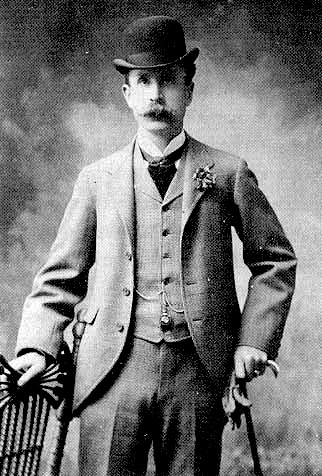
Born in New York City and raised in post-Civil War Brooklyn, George Tilyou witnessed firsthand the evolution of Coney Island from a quiet upper-class seaside retreat to the bustling playground of New York. His parents owned and operated The Surf House, a successful seaside restaurant. Even as a child it was apparent that George was a natural promoter. The story goes that he sold bottles of “authentic seawater” and boxes full of “authentic beach sand” to unwitting tourists who had never before seen the ocean, figuring that people would buy anything if it had a price tag. As it turned out, he was right. Tilyou owned and operated several attractions around Coney for several years. He took notice of a small operation called Sea Lion Park, the first enclosed amusement park. After seeing the possibilities, he decided to consolidate his attractions and build Steeplechase Park.
Tilyou’s reasoning for this was simple: he wanted more control over the area around his attractions. In those days, Coney was a haven for gambling, pickpockets, and prostitutes. By enclosing the park and charging an entrance fee, he kept the rougher element away and created a friendlier atmosphere for his patrons, thus establishing the model of the enclosed park and the pay-one-price structure as a standard. In addition to keeping out the ruffians, he also wanted a place where people would check their Victorian restraint at the door. George not only was a master showman, he also was quite the psychologist, who understood that people wanted to step away from the genteel culture of the late 1800’s and let their hair down. With this, Tilyou dubbed Steeplechase Park “The Funny Place,” and fashioned a diabolical grinning jester as the mascot, a very fitting image for the kind of irreverent, irresponsible fun the park promised its guests.
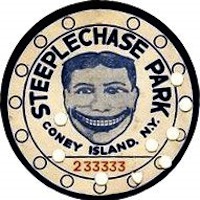
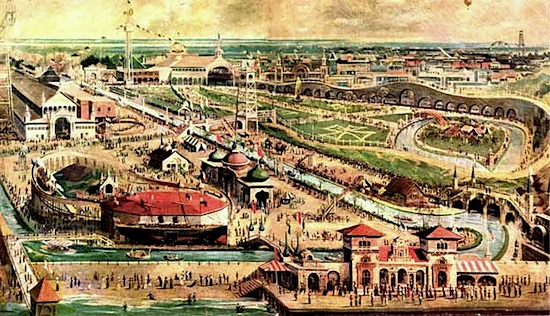
The signature ride of the park was the Steeplechase Horse ride. Drawing on the popularity of horse racing, it was a six-track, gravity-driven ride with two people to a wooden horse. To give the ride a hint of realism, Tilyou dressed ride attendants as jockeys, had a trumpeter at the start gate, and a taped finish line. Riders would race to the finish on an undulating coaster track that circled around the grounds.
It was a thrilling ride in its own right, but the real show was yet to come. Upon exiting the ride, guests would travel through a dimly lit maze. The exit led hesitant guests into an arena called the Blowhole Theatre and onto a bright stage with an audience of snickering people sitting in the stands. Here, blasts of air would shoot up through the floor…blowing up the women’s dresses. A dwarf with a cattle prod would eyeball and then shock the poor unsuspecting fellows, often times in the nether region. As the couple struggled to compose themselves, they left the stage through a gauntlet of clowns with slapsticks, more blowholes, and other obstacles that left them completely void of self respect and providing howls of laughter to the audience. Humiliated, they would join the crowd to laugh at the next batch of victims.
Other rides at Steeplechase were the Human Roulette Wheel, where guests would sit in the middle of a giant polished spinning disc. As the wheel spun faster and faster, guests would wildly slide off into a pit, slamming into each other.
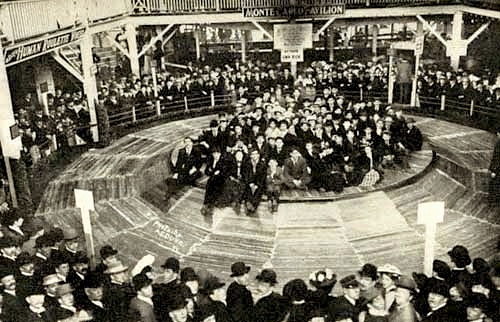
Similar simplistic machines like the Barrel of Love, The Human Pool Table, The Earthquake Stairway, and the Razzle Dazzle simultaneously embarrassed and delighted riders. There were normal attractions, but the majority of the park was dedicated to Tilyou’s brand of wild and careless fun. There was nothing sacred at Steeplechase. Customers were subject to being part of the show at anytime. There were collapsible park benches throughout the park, and gag attractions such as the “California Red Bats,” which actually were broken red bricks (brickbats) displayed in a faux museum. Tilyou worked diligently to keep the park fresh, making changes every year, and he never missed an opportunity to put on a show. After a fire in 1907 destroyed most of his park, the supreme showman posted a sign in the ashes that read…
I had troubles yesterday that I have not today
I have troubles today that I had not yesterday
On this site will be erected a bigger, better Steeplechase Park
Admission to the burning ruins – 10 cents
Tilyou did rebuild the park for the following season, this time adding a five-acre glass building called the Pavilion of Fun that housed several of the rides, enabling them to operate in the rain and bad weather.
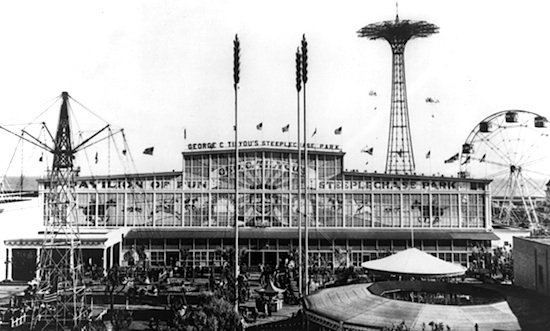
He died in 1914, leaving the park to his family. His son took over and carried the tradition for decades. Steeplechase Park proved to be the most venerable of the old Coney Island parks, surviving and remaining popular until its closure in 1964. The Parachute Drop Tower stands as the last relic.
While Fred Thompson’s Luna Park was a highly stylized visual masterpiece that entertained through themes and storytelling, Steeplechase’s appeal came from basic machines that stripped guests of their dignity, threw them against each other, and forced them into all kinds of compromising positions. This proved to be a very popular strategy in the rapidly changing, but still sexually repressed society of 1900. Tilyou didn’t see the point of excessive spending on visuals. He knew that the people were willing to be the visuals themselves. His brand of uninhibited, irreverent fun, coined by one writer of the day as “sanitized sex,” drew millions of visitors for nearly 70 years. In today’s litigious society, the park as it was probably wouldn’t last, but in an earlier time it was a sensation. Tilyou perfected the enclosed park model that is still followed to this day, and his psychological evaluation of customers and their needs lives on in the mission statement of everyone in the business.
On a side note, I was listening to a podcast about WDW's Boardwalk Hotel recently, and it discussed the many links between that resort and both Luna Park and Steeplechase. It is good to know Disney pays homage to those who made all the themed amusements of today possible.
Walt Disney's genius was in further perfecting the model that was already established, making it as isolated as possible,taking the concept of escapism to the extreme, and putting a much larger pile of money behind it. He was actually very much like Fred Thompson...an insanely creative boy at heart who spent freely on his ventures, told stories visually, and had a solid partner providing a business foundation for his creativity. The only real difference was that Walt always had Roy to come up with the money. Thompson's partner died after only a few years in business together.
This article has been archived and is no longer accepting comments.